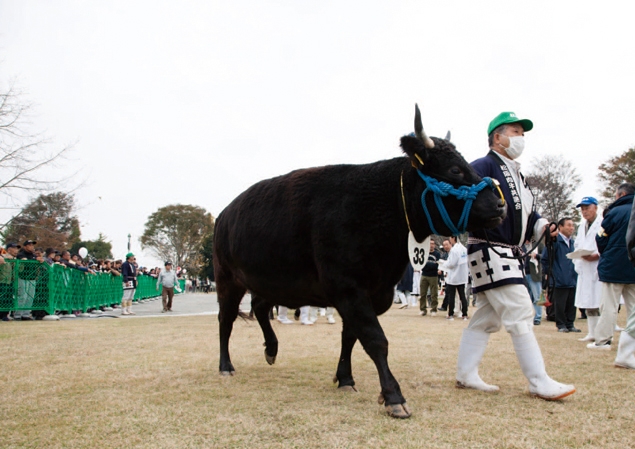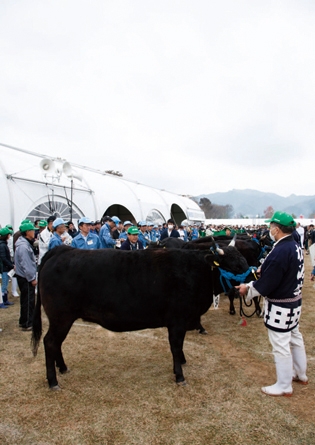The Day of Reckoning: Finding Japan's Top Matsusaka Cow No.1
Japan has several well-known beef cattle “brands”, at the pinnacle of which stand the cattle raised in Matsusaka.
Of these, Japanese Black heifers sourced from the Tajima and Awaji regions of Hyogo Prefecture and fattened for 900 days or more are in a class of their own, and are known as “premium Matsusaka beef cattle”.
Every November the Matsusaka Beef Cattle Competition (Matsusaka Nikugyu Kyoshinkai) is held. In 2015 a total of 50 of these majestic animals took part in the event, and following two hours of painstaking judging, the 686-kg Momomiya, a 1,007-day resident of a Matsusaka feedlot farm, was crowned the 66th queen of the Matsusaka cows.

Under the crowd's watchful eyes, cattle move from standby tent to judging area as their numbers are called, each one a magnificent beast raised with the utmost care by a beeffattening farmer.
Impressive to Behold, Shockingly Expensive to Buy, and Needless to Say, Incredibly Tasty Matsusaka Beef, the Ultimate Wagyu: a Visually-Arresting and Delicious Work of Art
Japan has over 200 beef cattle brands competing in terms of qua lity.
The three most famous are Matsusaka, Kobe, and Omi beef.
Of these, Matsusaka beef cattle are painstakingly fattened just a few head at a time by feedlot farmers.
Read on to find out what makes these particular cows so special .

Matsusaka beef is
characterized by its
deep red flesh and high-
quality, quick-melting
fat.
Isetan in Shinjuku, Tokyo is a well-known luxury department store, and its bustling basement food hall offers a tempting array of readymade dishes and bento boxes, dried goods, and confections both Japanese and western, plus regional specialties from across the country, and imported delicacies from around the world. The refrigerated meat cabinets occupying part of the fresh food section run for over twenty meters along the aisle. Strolling along and taking in the lineup of famous meat brands, one arrives at a sign proclaiming “Matsusaka beef” and a counter devoted to exactly that. This is the only butcher's shop I know of that specializes in a single brand of meat. Great chunks of Matsusaka sirloin have been placed almost reverently in the cabinet, their vivid scarlet flesh shot through with delicate veins of fat. The attractive display contains ranboso (part of the rump), oyster blade steak, aitch bone, and fillet. This is indeed a high temple of beef, an art gallery of bovine delectableness. The shop only deals in A5-grade Matsusaka beef, and aged beef at that, which makes for some eye-wateringly high prices: top-grade sirloin, for example, might sell for ¥10,800 per 100 grams (including tax). Even so, the massive hunks of meat visibly reduce in number day by day, and it isn’t long until the display needs to be completely restocked.
Matsusaka beef is brand beef in a class of its own. It is the flesh of Japanese Black cows who have not yet been in calf, fattened in a specific region of Mie Prefecture, and the term “Matsusaka beef” or “Matsusaka beef cow” applies only to cattle registered on a “Matsusaka beef unit identity control system” that contains information on bloodlines, birth, shipping and distribution. For the Japanese, Matsusaka beef is an aspirational meat, a treat for special occasions. What is less widely known is that there is another, even more special category of Matsusaka beef: “premium (tokusan) Matsusaka beef”.
